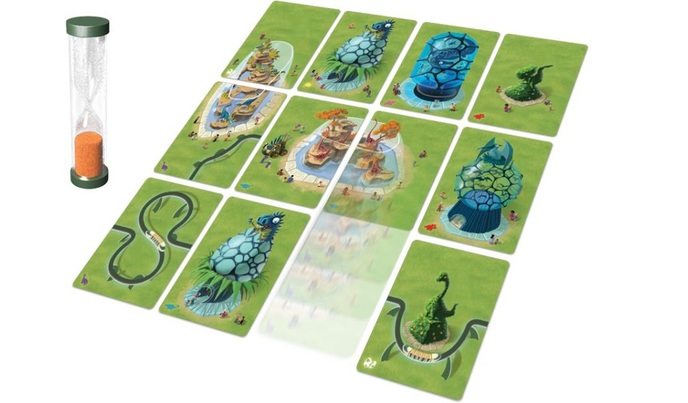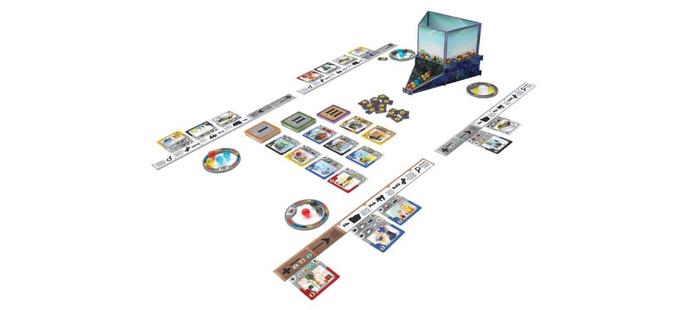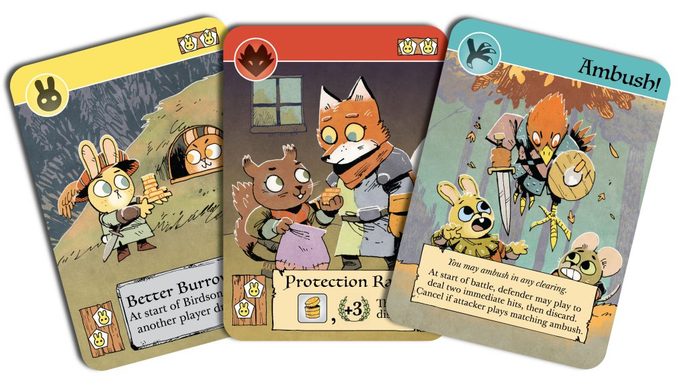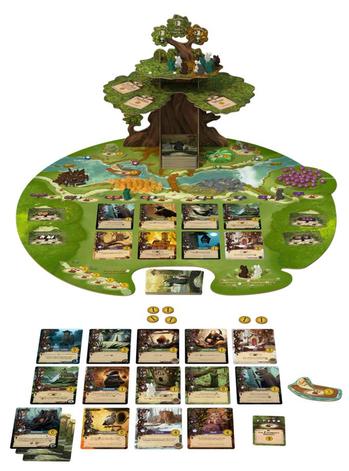
The time has come once again for Paste’s resident board game expert Keith Law to recap his favorite board games of the year. Without further ado…
10. Arkham Horror, Third Edition
I write this as someone familiar with the 2005 second edition but who never played it—I think this version of Arkham Horror is a big upgrade, because it streamlined a lot of rules, borrowing many from Eldritch Horror, so that it’s easier to play and at least no worse to set up. It’s a Lovecraft game, so there will be monsters, and you know you’ll have to protect both your character’s health and sanity. The board is variable, with five two-sided districts each comprising three neighborhoods as well as smaller street cards to connect them. Players work together as investigators, moving around the board to have Encounters, collecting clues, fighting monsters who pop up, and eventually hoping to get enough clues to advance the plot before you collect so many horror tokens that you lose. If an investigator dies or goes insane, you continue to play, discarding everything that investigator had and picking a new one, so it’s a hindrance but not a game-ender. The base game comes with four scenarios, but it’s an obvious candidate for new scenarios, requiring just a few new cards, or even a full expansion with more neighborhoods. I’ve also played this solo, taking on two or three investigators myself, and other than being very busy keeping track of things I thought it played well.
9. Mesozooic
This one slipped a bit under the radar, I think, but Mesozooic is a fun, light strategy game that forces things to move along by the use of a timer for a key part of your turns. The first phase of each round is simple card drafting—each player gets eleven cards from the main deck, chooses two, and passes them to the next player. Eventually you end up with eleven cards, and then you shuffle them and deal them to the table in a 4×3 pattern with the bottom right space left open. In phase two, someone flips the timer, and players have 45 seconds to rearrange the cards by sliding a card into the open space, trying to maximize their eventual point total by completing two-card enclosures, connecting monorails, or ensuring trucks are adjacent to big dinosaur features. When the timer is up, you stop moving cards and score. There’s also an advanced mode that adds additional scoring cards—some that score only if they end up in a corner of your zoo, or specifically on the top or bottom row—and a small expansion with even more options. It’s a small game in a small package with a small price point that makes it a great gateway option, too.
8. Villainous
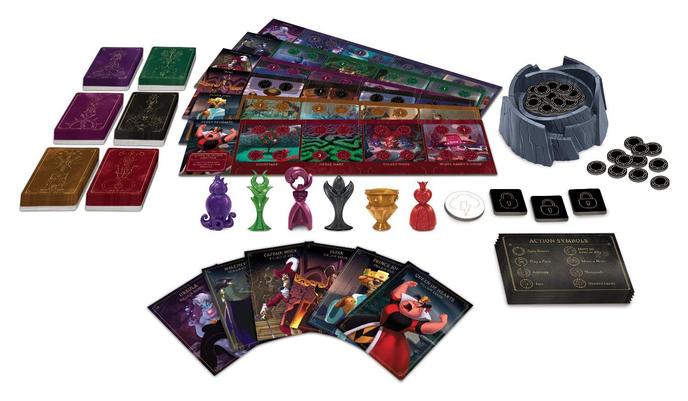
A fully licensed Disney product, Villainous is an asymmetrical deck management game—like a deckbuilder, but here you start with all your cards—that has players playing as any of six Disney villains, trying to achieve some specific evil goal before anyone else does. (Full disclosure: I am a full-time employee of ESPN, which makes me a Disney Cast Member. I received no special consideration from Disney for reviewing or mentioning this game anywhere.) The base game comes with the Queen of Hearts, Maleficent, Jafar, Captain Hook, Ursula, and, a bit incongruously, King John from Robin Hood. While turns are the same for each player—move your token to one of your four board spaces, undertake any or all of the two to four actions depicted using hand cards, redraw up to four at the end of your turn—your interim and long-term goals will be unique. All villains must contend with Heroes; you can use the Fate action to sic a hero or two on an opponent and try to slow them down. The game is inherently and obviously expandable, and I’d be shocked if we didn’t see this happen soon given the early response to this game—which isn’t just for kids, but might be a nice introduction to deckbuilding concepts without the added decisions of choosing what cards to buy or acquire.
7. Gizmos
Aesthetics do matter in board gaming; they’re no substitute for a good design, but an attractive board or notable component goes a long way, and Gizmos has it, with the central feature on the table a cardboard … well, I’m not saying it’s a gumball dispenser, but it’s a gumball dispenser. It’s just dispensing marbles, which are energy tokens you’ll claim and use to build cards representing science projects for your school’s science fair. Gizmos is at heart a lightweight engine builder that plays very quickly and rewards diligence in playing to the engine you’ve built. You can pick one of the six marbles in the chute of the gumball dispenser, or build a building from the display, or file a building to build it later, or ‘research’ by taking the top three cards of a building deck and then building or filing one of them. Each building enhances one of those actions—perhaps when you build a blue building, you’ll get to pick a marble for free; or, when you pick a yellow marble, you’ll get to pick one at random from the top of the dispenser. You can also get converter buildings that allow you to swap colors or count one marble of a specific color as two instead. The game ends when one player builds their 16th building or their 4th level 3 building, after which you add up all your points. Turns can be very quick to keep everyone engaged, and the satisfaction of building an efficient engine and then hitting those bonuses is a huge appeal. Also, there’s a gumball dispenser.
6. Cryptid
Cryptid looks like a very conventional board game, but it’s really a social deduction game played on a board, where the winning player is the first to guess which hex on the board houses the Creature. Each time you play, you use a card or the game’s website (playcryptid.com) to pick a board setup, where the six pieces are rotated in specific ways and connected, and then place six or eight buildings on assigned spaces. Then each player gets a secret clue that identifies something about the Creature’s location—for example, it’s within two spaces of a green structure, or it’s located on a desert or a swamp. On a turn, a player picks a space on the board and asks one opposing player if the creature could be there; the other player must answer yes or no, truthfully, placing a token there for their answer. Players may also search, placing a yes token on a square and then asking all other players in turn if the creature could be there; if all players say yes, then the player checks if that’s the correct spot and (if so) wins the game. The key is deducing everyone else’s clues before they guess yours, and knowing when you’re close enough to try to search, even though doing so might fail while revealing something about your own clue.
5. The Mind

The Mind is the least boardgamey board game on this list, but I think it’s also the most likely to leave everyone laughing or high-fiving during the game. The main deck in The Mind has 100 cards, numbered 1 to 100, and they’re shuffled together and dealt out to all players, N cards in round N. The players must then all discard their cards to the table, together, in ascending order … without communicating with each other in any way. That’s it, other than that you start the game with two ‘lives’ (so you can screw up once) and one shooting star (which, if played, allows all players to discard their lowest card to the table). I have gotten to the final level, round 12, in a two-player game, and we finally crashed and burned, but have yet to completely beat the game. We still fell apart laughing even though we fell just short. The game’s designer, Wolfgang Warsch, also won the Kennerspiel des Jahres this year for his game The Quacks of Quedlinburg, which just came out in the U.S. in late November.
4. Root
I feel like Alice Merton would hate this game. Root is a positively brutal game of competition among cuddly forest creatures, and it’s asymmetrical, so each player—the base game plays up to four, with expansions that get you up to six—has their own meeples, rules, and goals. The gist is that players are competing for control of parts of the forest, with the cats in charge at the start of the game (I own cats, and this checks out) but other creatures trying to erode their power … except the Vagabond, who runs around stealing tools and giving players back points or other rewards for doing so, so I guess it’s not really stealing after all, or at least that’s what the Vagabond tells himself at night. There’s a ton of interaction here—you really can’t win without fighting other players or trading with them, depending on your role—and the game experience can vary greatly because the rules for each faction are so different.
3. Welcome To
Welcome To’s publisher, Deep Water Games, has previously focused on importing games from Japan (often those published by Emperor S4, small box games with beautiful artwork), but this title is a big departure for them in a good way. Deep Water calls it a “roll and write game without the dice,” but I think of it as a party game for gamers, because it scales to any number of players—up to 100, according to the box, and that’s only because you’ll run out of paper to write on if you have more players than that. On each turn, players can choose from three pairs of cards, each containing a house number from 1 to 15 and one of the game’s six actions. You write the house number on one of the three streets on your personal town, and then take the action, which may involve building a pool on that house, or a park on that street, or building a fence to split your street up into smaller estates, or using the realtor action to make estates of a specific size worth more points. There are many ways to score, including city plan cards that you can complete by building a set number of estates of specific sizes, and the odds are that no two players will choose the same path. It’s low on interaction, so it’s not really a party game, but it’s smart enough for serious gamers while fun and quick enough to play with a big crowd.
2. Charterstone
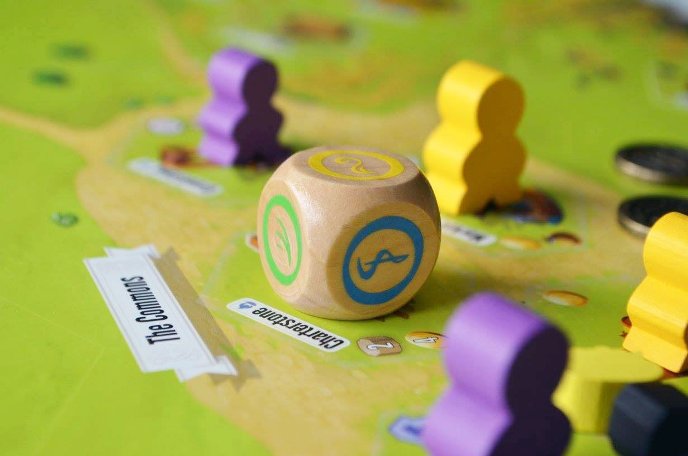
Legacy games are in now—Ultimate Werewolf just got the legacy treatment, and now Clank! Is getting one too—but Charterstone is one of the few standalone legacy games, rather than an adaptation of an existing game into the legacy format. (A legacy game is one where each time you play the game, you may change part of it, whether it’s the board or cards or even adding/deleting rules, generally playing to a storyline over a dozen or so play sessions.) Charterstone is also a worker placement game, and as in so many such games you’re gathering wood and stone and other resources and then using them to build buildings on the board—in this case, sticking decals on the board when you build. But each play of Charterstone has players opening ‘crates’ that add new cards, new rules, new meeple types, new goals, even new resources to gather, so that while your first two plays are a bit ho-hum, by play seven or eight, the game has exploded into this complex endeavor with short- and long-term rewards to consider. The story that comes with the game is a little superficial, but the game play itself is superb, and it’s also an extremely fine-tuned design.
1. Everdell
It’s so cute you might dismiss Everdell as a kids’ game, or something that’s all style and no substance, but you’d be wrong: this game is fun, it is clever, and its design is meticulous. Everdell is like Stone Age just got the ultimate upgrade, combining worker placement and resource collection with tableau-building and adorable meeples. Players place their workers on spaces to gather resources or, later, claim rewards, and then use resources to buy cards and build them in their ‘cities,’ gaining more abilities and sometimes the right to acquire other cards free later (as in 7 Wonders). The real beauty of the design is that you don’t get all your workers at the start of the game, adding one or two in each ‘season,’ so the ramp-up is gradual, it’s hard for any one player to get too far ahead, and game times are manageable—under an hour for sure, as quick as 30 minutes for a two-player game in our experience. And the components really are gorgeous, especially in the collector’s edition.
Keith Law is a senior baseball writer for ESPN.com and an analyst on ESPN’s Baseball Tonight. You can read his baseball content at search.espn.go.com/keith-law and his personal blog the dish, covering games, literature, and more, at meadowparty.com/blog.

